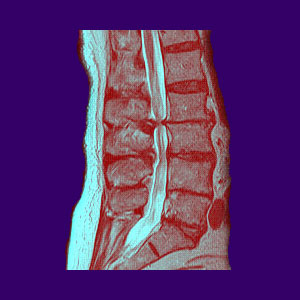
Ligamentum flavum thickening describes a condition in which the spinal ligamentum flavum demonstrates degenerative or inflammatory changes that result in it swelling noticeably. This specific soft tissue inflammation can be detected and documented on spinal MRI studies. The usual and correct medical term for this condition is ligamentum flavum hypertrophy. In most cases, this condition is a nonissue for back pain sufferers, but in some specific cases, the thickening of the yellow ligament may contribute to symptoms, most often through the mechanism of central spinal stenosis.
This dissertation investigates a specific type of ligamentous hypertrophy in the spinal anatomy which may result in negative consequences for vertebral function.
What is Ligamentum Flavum Thickening?
The ligamentum flavum is a connective tissue which links the individual vertebrae together. It connects inside the vertebral structure, posterior to the central canal. Being that this structure basically forms the rear border of the central spinal canal, thickening of the ligament will decrease the available space within the rear of the canal.
Usually this structural change is not a problem, but in cases where there is already a considerably narrowed spinal canal due to congenital condition, developmental condition, back injury or other narrowing process, the combination of factors can compress the spinal cord, eliciting potentially serious symptoms anywhere below the affected level.
Ligamentum Flavum Hypertrophy
When patients demonstrate a thickened ligamentum flavum, but do not have other sources of significant central canal stenosis at the same vertebral level, the condition is usually viewed as being innocent. In a few cases, it may be blamed for causing pain, but this diagnosis is almost always incorrect; an idea supported by poor treatment results for dedicated ligamentum hypertrophy conditions.
When a prolapsed disc or spinal arthritic process has already narrowed the central canal to a large degree on the anterior surface or lateral surfaces, and the ligamentum flavum has narrowed the rear of the canal, then diagnosis of symptomatic stenosis may well be correct. In these cases, decompressive back surgery is often recommended, and in some patients, is truly required.
Ligamentum Flavum Thickening Advisory
No one knows exactly why the ligamentum thickens in some patients and not in others. As we age, it is normal to experience some hypertrophic change in this ligamentous structure, but in other cases, the source is deemed to be the result of a spinal abnormality or spinal injury.
In many circumstances, the cause is idiopathic, as is common with some many back pain conditions.
If you have been diagnosed with central stenosis of the spinal canal caused by, or contributed to, by ligamentum flava hypertrophy, remember to learn the facts before seeking treatment. This is especially true for those patients who are currently thinking about undergoing spinal surgery. Remember, the surgical treatment path should always be avoided, unless no other noninvasive option exists.




